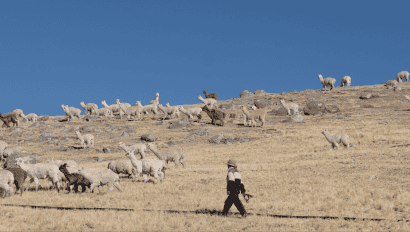Imagining a Circular Future for Polyester with Reju

The fashion industry stands at a critical crossroads when it comes to polyester—a fiber that dominates global textile production. Reju is driving transformation with its innovative Regeneration Hubs, where textile waste is given a new life. But scaling textile-to-textile recycling requires far more than innovation alone. It demands a coordinated, industry-wide shift. In this conversation, Reju CEO Patrik Frisk outlines what a truly circular system for polyester looks like, the barriers that remain, and why now is the time for urgent, collaborative action.
Patrik, you’ve said before that what the industry needs is not just a single solution, but an entirely new system. What does a truly circular system for polyester look like?
I’ve been in this industry my whole life, and the reason I do what I do today is I want to be part of creating an opportunity for the industry to become more circular.
Polyester, specifically, is one of the most prevalent fibers, and it’s also the one that lends itself best to circularity because of its chemical structure. Both the problem and the opportunity with polyester is that it is a chemical, petroleum-based material that can be recycled infinitely, provided that you have the setup both upstream and downstream to allow for that. We are now at a stage where we’re able to build the circular system, if we can bridge the gap between the aggregation of textile waste and the reinsertion into the supply chain.
So, what we’re busy doing here at Reju is making sure that we’re connecting the dots—that is the new system that I’ve talked about. And integral to that system is an ability to sort waste at scale, to prepare waste at scale, to recycle it at scale, and then ultimately to reinsert it back into the supply chain of the brands and retailers that are using this product at ever-increasing rates.
According to our Materials Market Report, last year, around 78 million tonnes of polyester was produced, with virgin polyester production continuing to rise. It’s clear we’re at a critical point for the fashion, apparel, and textile industry. How can we build the urgency needed to drive industry-wide action and what progress can we realistically expect in the next five years?
I think we were all hoping that we would be helped by some of the frameworks that have been discussed, specifically in Europe the Waste Framework Directive and the updated Extended Producer Responsibility (EPR) initiatives. It is certainly something that everybody’s very much aware of, but there isn’t a set framework for brands to react to, so we need the frameworks that are now being put in place to be effective. They need to be as homogeneous as possible so people can follow them in the easiest possible way. And it needs to be coordinated and it needs to make sense. If it doesn’t make sense for the industry, the industry is not going to play along. It’s as simple as that.
People in our industry would prefer not to change and I think that is a very short-sighted approach because firstly, we’re dealing with a finite material, and secondly, the waste that this industry is creating has dramatically increased. The Boston Consulting Group (BCG) report that came out, dealing with Europe specifically, discussed the amount of waste that’s now aggregating and the difficulty of making that waste go away.
We need to find a new way to deal with this waste issue, and we believe that circularity is the answer. I think we should all also have a sense of urgency because it’s going to take a long time to make circularity happen at scale, because you have to build all the infrastructure, and that takes time, it takes money, it takes effort—so we’d better get started.
“I think we should all also have a sense of urgency because it’s going to take a long time to make circularity happen at scale, because you have to build all the infrastructure, and that takes time, it takes money, it takes effort—so we’d better get started.”
You mentioned it takes money, and it is hard to ignore the economic barriers to change. Solutions like scaling textile-to-textile polyester are significantly more expensive than producing virgin materials, so how can we incentivize the extra investment that is realistically needed for brands to make the switch?
EPR should definitely be one of the levers, in terms of making sure that there is a pay-to-play for the brands or the retailers as they enter a product into the market. There should also be an incentive, where they can get some money back if they’re using a product that’s manufactured in this new system and then reintegrating it back into their own product.
In reality, for any sizeable brand or retailer, the impact of starting to switch to a regenerated product for circularity is going to be negligible. We’re talking about a material, inside a yarn, inside a fabric, inside a garment, inside a distribution system. The actual cost component of polyester itself in the value chain of building a garment is very small. So even if you double or triple the cost of the material, the impact on margin and ultimately also end consumer price is very low.
What we have to ask ourselves is, do we have the intent to move to a better place? Are we interested in creating a circular system for this fiber that comes from a finite resource? In some cases, it’s just good business in the long term. If this material is going to become scarce and it’s likely it will be more regulated over time, it would be smart to get access to it early on. Some brands and retailers are simply looking at it as a de-risk strategy.
At Reju, we see this as an opportunity, because we’re also advocating for higher standards. So, if we’re making polyester from all this waste or extracting or refining the polyester, we can consistently establish a better-quality end product. This means we can build better yarns and better fabrics, with fewer bad chemicals the second time around. We know that although the consumer might not necessarily pay for something green, they’ll pay for something better or higher performing. Nicer to wear, better drape—that’s what the consumer will pay for.
Being able to turn the problem of waste into a solution, as your Regeneration Hubs are doing, is a great example of innovation. What are potential barriers to creating similar innovations in the sustainable textile space?
I love this question because I think that’s exactly how we should be looking at this. The case I’ve been trying to plead at the European Union level, with various states in the US, and with the brands and retailers, is to look at this as an opportunity. Collectively, let’s take this as an opportunity to innovate and create competitive advantages in the industry. At Reju, we continue to innovate. Our technology originates from IBM and has since gone through several stages of innovation and we have a very strong R&D in polymer science at Technip Energies.
The fashion industry is still at the very beginning of a transformation, and the opportunities in terms of innovation at every stage are tremendous.
I find it hard to understand why that’s not happening when this industry is built on innovation. That’s what we do. We innovate from a design perspective all the time, but when it comes to us taking responsibility for the waste we create, suddenly we don’t want to innovate at all. I don’t understand it. I think it’s a big opportunity.
“The fashion industry is still at the very beginning of a transformation, and the opportunities in terms of innovation at every stage are tremendous.”
What role should policymakers and governments play in accelerating sustainable innovation and are they doing enough to support transformative change in the industry?
I think they’re doing as much as they probably can. I’ve learned a lot about the work that’s happening at the EU level and also at state levels in the US to try to find a path that can accommodate many different stakeholders. It is important to put something in place that’s going to work for everyone, and that takes time.
I’m very hopeful, especially with certain policies at the country level in Europe. For example, the Netherlands has set the goal to become fully circular by 2050, making the case for circularity as a strategy. We’re already using up too many resources and we need to figure out a way to get better at reusing and remaking things from what’s already been harvested. Programs like that one make me incredibly optimistic.
The Regeneration Hubs are a result of a successful collaboration with organizations such as Goodwill and Waste Management. How essential are collaborations like these in driving change and how have you managed the differing goals and priorities of these organizations?
We have relationships with over 130 different waste management sorters and we now have agreements with more than 20, including Goodwill and Waste Management, but also others like Cibutex, NFT (Nouvelles Fibres Textiles), Circle-8 and more around Europe. We’re preparing for the future, and also helping them plan, because their future, especially on the sorter side, is in peril. The entire secondhand market is in trouble because they are struggling to ship to many countries they have shipped to in the past and they are being undercut on price by certain players in the fashion space, which is making their offer more expensive. There have been a lot of changes in market dynamics recently, so in order to support the companies upstream and make sure that we’re providing a view of the future, we’re signing long-term contracts with them.
We’re building a circular system, and that is a large undertaking. It requires involvement all the way upstream, from waste aggregation, to the municipal level, to non-profits. We’re working together to create this new system for the future.
On the topic of waste management, currently 98% of recycled polyester comes from plastic bottles. What needs to change to meaningfully reduce this percentage and scale textile-to-textile recycling?
It’s an interesting conundrum we’ve created for ourselves. I was part of that initiative when it began in the 1990s. At that point in time, it made a lot of sense to take the bottles that were laying around and make them into yarns. And in the beginning the quality was horrible. You really have to wonder why we’re still doing it.
The reality is that by making polyester from plastic bottles, you create a worse product than if you were using virgin textiles. It’s not just that it isn’t sustainable, it’s that the outcome is a lower quality product, which has to be mixed with virgin polyester to make it work. It comes back to the quality of the product.
“We’re already using up too many resources and we need to figure out a way to get better at reusing and remaking things from what’s already been harvested. Programs like that one make me incredibly optimistic.”
With polyester accounting for 59% of global fiber production in 2024, up from 57% in 2023, should we be focusing on reducing overall polyester consumption, or scaling circular solutions that repurpose existing waste?
Right now, polyester production infrastructure across the world is not being maximized, so there’s a lot of capacity for making even more polyester that’s not utilized, and production will continue to increase with demand.
We don’t have a replacement in textiles for polyester. It’s cheap, it’s reliable, it’s resistant to heat and cold, and it’s durable. The problem with it is that there are only two ways to get rid of it: you either burn it, which is costly and creates a lot of carbon emissions, or you dig it into the ground, where it will continue to shed microplastics for a very long time. We have to find a way to reuse what we’ve got.
I do think that we need to educate the consumer in different behaviour, but we could also make sure that what we put out there second time around is a better product—one that’s more durable and less harmful to the environment. I don’t think we should try to trick ourselves into thinking that the consumer is not going to continue to consume. I simply don’t believe that. But I think our responsibility is to make sure that whatever we put out there is better, the second time around.
We’ve talked about these challenges, which are significant, but what gives you hope and confidence that we can move fast enough to meet the scale of the waste crisis?
I think we can do it. I know the technology exists and I think there are enough serious brands and retailers out there that are looking at this holistically and seeing that it’s just good business. They’re going to be able to create better products, and at the same time de-risk their business and supply chain.
I think the fact that there are companies like Reju, that have their roots in engineering, and have resources to build—that’s something that’s very much needed. We built our Regeneration Hub Zero in Frankfurt in 11 months. It contains 200 process instruments, 500 valves, 2.4 kilometres of piping, and 4 kilometres of electrical wire, and when you walk in there, you realize the complexity of what we’ve created. There is a need for serious companies like Reju that understand how to execute that at scale. It gives me hope to be part of an organization that can do that.
Another thing that makes me hopeful is the fact that we can make better stuff through this very arduous process that we have. I think Reju is a hopeful brand. We believe this can be done and we need to make sure that people understand how important it is. It’s about circularity—that’s what we need to create in this industry to be able to create an opportunity for the next generation. So let’s be hopeful. Let’s be optimistic. Let’s do this right.


